环氧固化剂MSDS
- 格式:docx
- 大小:13.80 KB
- 文档页数:4
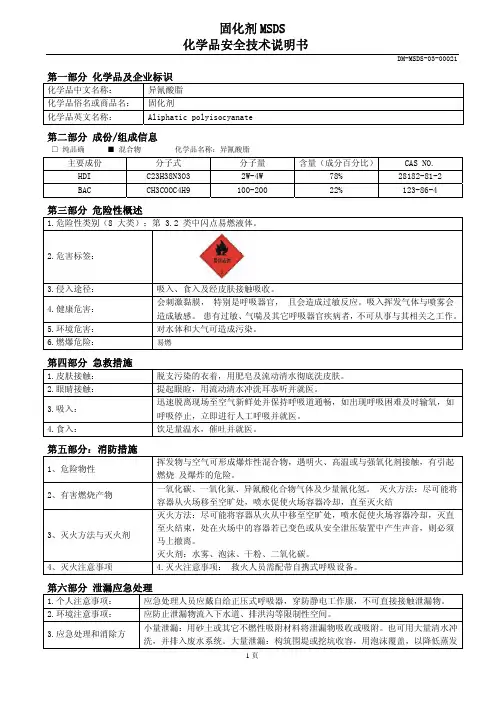
第一部分 化学品及企业标识化学品中文名称: 异氰酸脂 化学品俗名或商品名: 固化剂化学品英文名称:Aliphatic polyisocyanate第二部分 成份/组成信息□ 纯品确 ■ 混合物 化学品名称:异氰酸脂主要成份 分子式分子量 含量(成分百分比)CAS NO. HDI C23H38N3O3 2W-4W 78% 28182-81-2 BACCH3COOC4H9100-20022%123-86-4第三部分 危险性概述1.危险性类别(8 大类):第 3.2 类中闪点易燃液体。
2.危害标签:3.侵入途径: 吸入、食入及经皮肤接触吸收。
4.健康危害: 会刺激黏膜, 特别是呼吸器官, 且会造成过敏反应。
吸入挥发气体与喷雾会造成敏感。
患有过敏、气喘及其它呼吸器官疾病者,不可从事与其相关之工作。
5.环境危害: 对水体和大气可造成污染。
6.燃爆危险:易燃第四部分 急救措施1.皮肤接触: 脱支污染的衣着,用肥皂及流动清水彻底洗皮肤。
2.眼睛接触: 提起眼睑,用流动清水冲洗耳恭听并就医。
3.吸入: 迅速脱离现场至空气新鲜处并保持呼吸道通畅,如出现呼吸困难及时输氧,如呼吸停止,立即进行人工呼吸并就医。
4.食入:饮足量温水,催吐并就医。
第五部分:消防措施1、危险物性 挥发物与空气可形成爆炸性混合物,遇明火、高温或与强氧化剂接触,有引起燃烧 及爆炸的危险。
2、有害燃烧产物一氧化碳、一氧化氮、异氰酸化合物气体及少量氰化氢。
灭火方法:尽可能将容器从火场移至空旷处,喷水促使火场容器冷却,直至灭火结3、灭火方法与灭火剂灭火方法:尽可能将容器从火从中移至空旷处,喷水促使火场容器冷却,灭直至火结束,处在火场中的容器若已变色或从安全泄压装置中产生声音,则必须马上撤离。
灭火剂:水雾、泡沫、干粉、二氧化碳。
4、灭火注意事项4.灭火注意事项: 救火人员需配带自携式呼吸设备。
第六部分 泄漏应急处理1.个人注意事项: 应急处理人员应戴自给正压式呼吸器,穿防静电工作服,不可直接接触泄漏物。
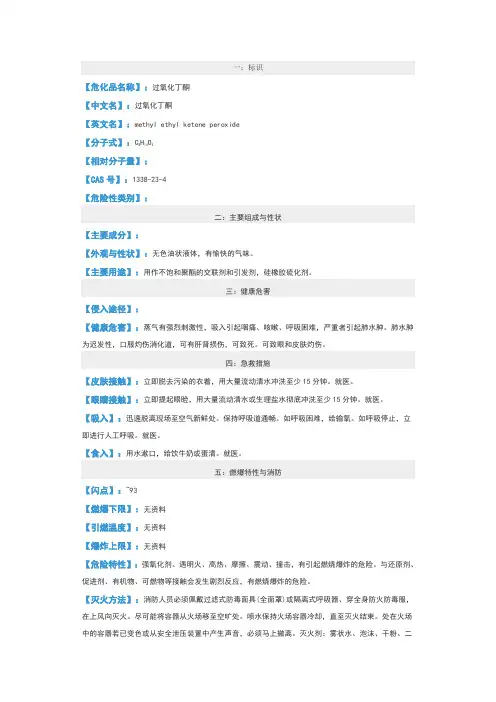
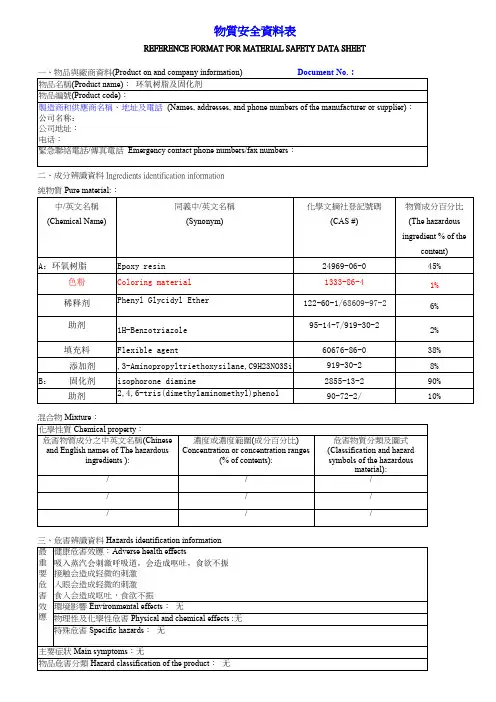
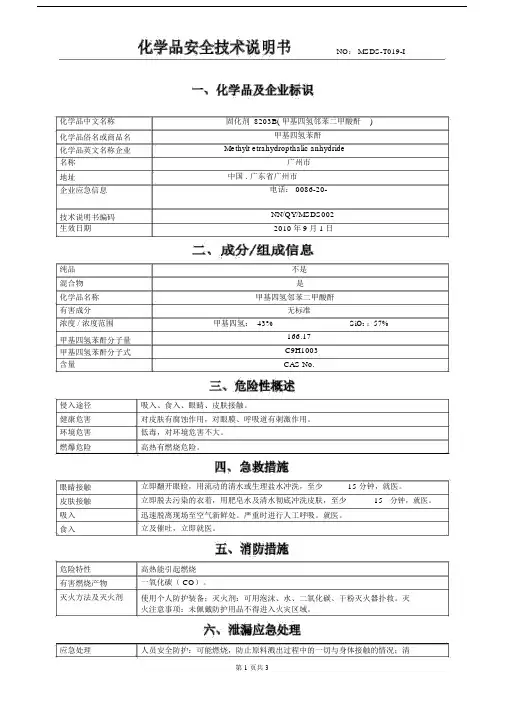
NO: MSDS-T019-I化学品中文名称化学品俗名或商品名化学品英文名称企业名称地址企业应急信息技术说明书编码生效日期纯品混合物化学品名称有害成分浓度 / 浓度范围甲基四氢苯酐分子量甲基四氢苯酐分子式含量侵入途径健康危害环境危害燃爆危险眼睛接触皮肤接触吸入食入危险特性有害燃烧产物灭火方法及灭火剂应急处理固化剂 8203B( 甲基四氢邻苯二甲酸酐)甲基四氢苯酐Methylt etrahydropthalic anhydride广州市中国 . 广东省广州市电话: 0086-20-NN/QY/MSDS0022010年9月 1日不是是甲基四氢邻苯二甲酸酐无标准甲基四氢: 43%SiO2:57%166.17C9H1003CAS No.吸入、食入、眼睛、皮肤接触。
对皮肤有腐蚀作用,对眼膜、呼吸道有刺激作用。
低毒,对环境危害不大。
高热有燃烧危险。
立即翻开眼睑,用流动的清水或生理盐水冲洗,至少15 分钟,就医。
立即脱去污染的衣着,用肥皂水及清水彻底冲洗皮肤,至少15分钟,就医。
迅速脱离现场至空气新鲜处。
严重时进行人工呼吸。
就医。
立及催吐,立即就医。
高热能引起燃烧一氧化碳( CO)。
使用个人防护装备;灭火剂:可用泡沫、水、二氧化碳、干粉灭火器扑救。
灭火注意事项:未佩戴防护用品不得进入火灾区域。
人员安全防护:可能燃烧,防止原料溅出过程中的一切与身体接触的情况;清理大量泄漏物时,要仔细分析;在安全情况下,切断泄漏源。
环境保护措施:用沙子、泥土和其它不燃的物质覆盖统一处理,以防产品流入下水道、水沟和河流;禁止污染土壤和水体。
泄漏处理:小量泄漏:穿戴规定的防护服,正常操作,用沙子、泥土或溢出吸收物吸收或取出液体;放置于有标签的密封容器中,以备以后的安全处理;大量泄漏时,构筑围堤,挖坑收容后处理掉。
操作处置注意事项操作人员必须严格遵守操作规程,建议操作人员戴防腐手套、穿工作服、防止皮肤接触。
远离火种、热源、工作场所严禁吸烟。
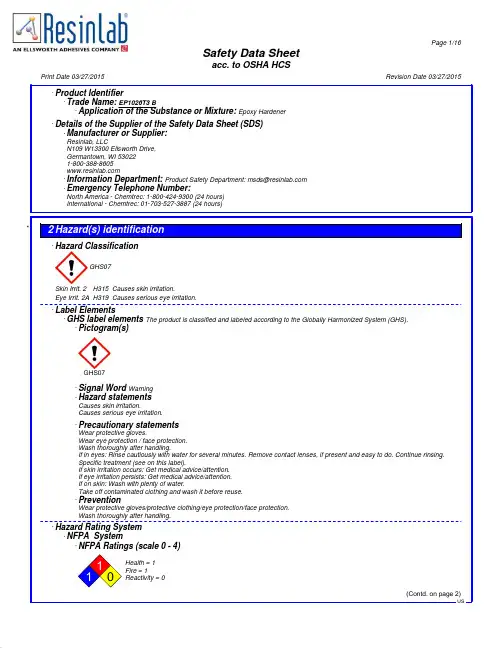
Page 1/16Safety Data Sheetacc. to OSHA HCSPrint Date 03/27/2015Revision Date 03/27/2015· Product Identifier· Trade Name:EP1026T3 B· Application of the Substance or Mixture:Epoxy Hardener· Details of the Supplier of the Safety Data Sheet (SDS)· Manufacturer or Supplier:Resinlab, LLCN109 W13300 Ellsworth Drive,Germantown, WI 530221-800-388-8605· Information Department:ProductSafetyDepartment:*****************· Emergency Telephone Number:North America - Chemtrec: 1-800-424-9300 (24 hours)International - Chemtrec: 01-703-527-3887 (24 hours)Hazard ClassificationSkin Irrit. 2Eye Irrit. 2AGHS07Print Date 03/27/2015Revision Date 03/27/2015 Trade Name:EP1026T3 B1,3-Bis[3-(dimethylamino)propyl]ureaSkin Irrit. 2, H315; Eye Irrit. 2A, H319Siloxanes and Silicones, di-Me, reaction products with silicasilicon dioxide, chemically preparedSTOT SE 3, H335Classification System:Print Date 03/27/2015Revision Date 03/27/2015 Trade Name:EP1026T3 B(Contd. of page 2)· Indication of any Immediate Medical Attention and Special Treatment Neededskin testsCheck section 11 Toxicological Information for further relevant information.· Additional InformationFor additional information, please consult the corresponding first aid measures in the most current version of Emergency Response Guidebook which is produced by the US Department of Transportation.Print Date 03/27/2015Revision Date 03/27/2015 Trade Name:EP1026T3 B(Contd. of page 3) Allow molten product to cool.Absorb residues with liquid-binding materials.For small spills:Ventilate and wash area after clean-up is complete.Collect spills in suitable and properly labeled containers.Do not use solvents unless following safe handling practices and within the recommended exposure guidelines.Dispose contaminated chemicals as waste according to Section 13.· Additional Information No further relevant information.Print Date 03/27/2015Revision Date 03/27/2015 Trade Name:EP1026T3 B(Contd. of page 4)· Hand ProtectionProtective glovesSelection of glove material should take into consideration the penetration times, rates of diffusion, and the degradation.Suggested glove type(s):Nitrile GlovesButyl Rubber Gloves· Eye ProtectionSafety glasses· Body Protection No relevant information.· Additional InformationAll protective clothing (suits, gloves, footwear, headgear) should be clean, available every day, and put on before work.The Engineering measures or controls, and PPE recommendations are only guidelines and may not apply to every situation. For additional information, please consult the corresponding requirements under OSHA 29 CFR 1910.94-95, and 29 CFR 1910.132-138.Print Date 03/27/2015Revision Date 03/27/2015 Trade Name:EP1026T3 B(Contd. of page 5)· Additional Information No further relevant information.Print Date 03/27/2015Revision Date 03/27/2015 Trade Name:EP1026T3 B(Contd. of page 6) 67762-90-7Siloxanes and Silicones, di-Me, reaction products with silicaDermal LD50 (Test species: n/a) (Toxicity not expected based on acute oral data)Based on the acute oral toxicity test, it was expected that toxicity to mammals via dermal application of the substance wasnot a significant concern and resulted in a similar lack of acute toxicity. Thus, the substance was not classified as an acutedermal hazard as a wetted form.112945-52-5silicon dioxide, chemically preparedDermal LD50> 2000 mg/kg (rabbit)Reference: OECD SIDS (2004) and IUCLID Dataset (2004).· Potential Health Effect(s):Not a classified acute dermal hazard.· InhalativeMercaptan Terminated Polymer-non hazardousInhalative LC50/4 h (No data available)52338-87-11,3-Bis[3-(dimethylamino)propyl]ureaInhalative LC50/4 h not determined mg/l (rat)Reference: BASF SDS 201567762-90-7Siloxanes and Silicones, di-Me, reaction products with silicaInhalative LC50/4 h (Test species: n/a) (Toxicity not expected based on acute oral data)Due to wetted form of the substance, inhalative effects from dust form can be seen as negligible. Meanwhile, basedon the acute oral toxicity test, it was expected that toxicity to mammals via inhalation of the substance was not asignificant concern and resulted in a similar lack of acute toxicity. Thus, the substance was not classified as an acuteinhalation hazard.112945-52-5silicon dioxide, chemically preparedInhalative LC50/4 h> 2.08 mg/l (rat)No animals died.Nasal discharge during exposure, crusty eyes, crusty nose and alopecia at days post-exposure.Reference: OECD SIDS (2004) and IUCLID Dataset (2004).· Potential Health Effect(s):No further relevant information; classification is not possible.· Skin Corrosion or IrritationMercaptan Terminated Polymer-non hazardousCorrosion/Irritation slightly irrit. (rabbit) (Draize score: 1.2/8 (Max. 8))Reference: Gabriel Performance Products (M)SDS (2005).52338-87-11,3-Bis[3-(dimethylamino)propyl]ureaCorrosion/Irritation irritating (Test species: n/a) (based on product w/ similar structure/composition)Reference: BASF SDS (2015).67762-90-7Siloxanes and Silicones, di-Me, reaction products with silicaCorrosion/Irritation Non-irritating (Test species: n/a) (Primary irritation index=0)mildly irritating (rabbit) (Read across from CAS 63148-62-9)No test detail available; for safety reasons, the substance was classified as mildly irritating (Category 3) to rabbit skin.Reference: HSNO CCID (2010).112945-52-5silicon dioxide, chemically preparedCorrosion/Irritation not Irritating (rabbit) (OECD TG 404)Reference: OECD SIDS (2004) and IUCLID Dataset (2004).· Potential Health Effect(s):Causes mild skin irritation.In contact with skin, may cause:redness and pain· Eye Serious Damage or IrritationMercaptan Terminated Polymer-non hazardousDamage/Irritation slightly irrit. (rabbit) (Draize score: 16.8/110 (Max. 100))Reference: Gabriel Performance Products (M)SDS (2005).(Contd. on page 8)USPrint Date 03/27/2015Revision Date 03/27/2015 Trade Name:EP1026T3 B(Contd. of page 7) 52338-87-11,3-Bis[3-(dimethylamino)propyl]ureaDamage/Irritation irritating (Test species: n/a) (based on product w/similar structure/composition.)Reference: BASFSDS (2015).67762-90-7Siloxanes and Silicones, di-Me, reaction products with silicaDamage/Irritation slightly irrit. (Human) (Read across from CAS 63148-62-9)non-irritating (Primary irritation index=0)Transient ocular irritation was observed in humans, rabbits, dogs, and monkeys after injection of the substance to theireye bodies. However, those effects can be seen as negligible based on regular use of the substance. When applyinglower viscosity substance-oil mixture to human and rabbit eyes, there was no cornea injury, but a delay of healing of theexisted corneal erosion observed. For safety reasons, the substance was classified as a slight eye irritant (Category2B).Reference: ACToR (2011) and Cabot (M)SDS (2012).112945-52-5silicon dioxide, chemically preparedDamage/Irritation slightly irrit. (Human)Studies have shown this substance to be slighlty irritating.Reference: OECD SIDS (2004).not irritating (rabbit) (OECD TG 405)Reference: OECD SIDS (2004) and IUCLID Dataset (2004).· Potential Health Effect(s):Causes eye irritation.In contact with eye, may cause:redness and painunlikely to cause corneal injuries· Respiratory or Skin SensitizationMercaptan Terminated Polymer-non hazardousSensitization Skin not sensitizing (guinea pig)Reference: Gabriel Performance Products (M)SDS (2005).Respiratory (No data available)52338-87-11,3-Bis[3-(dimethylamino)propyl]ureaSensitization Skin sensitizing (Test species: n/a)Reference: BASF (M)SDS (2011).Respiratory (No data available)67762-90-7Siloxanes and Silicones, di-Me, reaction products with silicaSensitization Skin (No data available)Primary irritation index=0 Non-irritating.Cabot MSDS (2012)Respiratory (No data available)112945-52-5silicon dioxide, chemically preparedSensitization Skin not sensitizing (guinea pig)There was a case of allergic dermatitis developing after a contact exposure of the skin to the substance. Aviolated intactness of the skin integument that may be responsible for the allergic reaction. In general, thissubstance is not sensitizing.Reference: OECD SIDS (2004).· Potential Health Effect(s):May cause an allergic skin reaction.No relevant information for respiratory sensitization; classification is not possible.· OSHA-Ca (Occupational Safety & Health Administration)None of the ingredients is listed.· Germ Cell MutagenicityMercaptan Terminated Polymer-non hazardousMutagenicity (No data available)(Contd. on page 9)USPrint Date 03/27/2015Revision Date 03/27/2015 Trade Name:EP1026T3 B(Contd. of page 8) 52338-87-11,3-Bis[3-(dimethylamino)propyl]ureaMutagenicity (No data available)67762-90-7Siloxanes and Silicones, di-Me, reaction products with silicaMutagenicity negative (Chinese Hamster) (In Vitro (AMES Test))negative (Chinese Hamster) (In Vitro (Chromosomal aberration in ovary cells))Reference: Cabot (M)SDS (2012).112945-52-5silicon dioxide, chemically preparedMutagenicity negative (-)Inhalation stuides show positive results in mice with low incidence of benign tumors and negative result in rat. The substanceis not listed as a carcinogen by NTP, OSHA, or ACGIH. Classified as a Group 3 Carcinogen by IARC.Reference: OECD SIDS (2004) and IUCLID Dataset (2004).· Potential Health Effect(s):No further relevant information; classification is not possible.· CarcinogenicityMercaptan Terminated Polymer-non hazardousCarcinogenicity negative (Test species: n/a) (not listed as a Carcinogen by NTP, IARC or OSHA)52338-87-11,3-Bis[3-(dimethylamino)propyl]ureaCarcinogenicity (Test species: n/a) (not listed as a Carcinogen by NTP, IARC or OSHA)67762-90-7Siloxanes and Silicones, di-Me, reaction products with silicaCarcinogenicity (Test species: n/a) (Not listed by IARC, NTP, OSHA or ACGIH)112945-52-5silicon dioxide, chemically preparedCarcinogenicity negative (salmonella typhimurium)In Vitro (Ames Test) - Negative with and without metabolic activation.Reference: OECD SIDS (2004) and IUCLID Dataset (2004).negative (Chinese Hamster)In Vitro (HGPRT Assay in CHO cells) - Negative with and without metabolic activation.In Vitro (Chromosomal abberation in CHO cells) - Negative with and without metabolc activation.Reference: OECD SIDS (2004) and IUCLID Dataset (2004).negative (Escherichia coli)In Vitro (Reverse Mutation Assay) - Negative with and withou metabolic activation.Reference: OECD SIDS (2004) and IUCLID Dataset (2004).negative (Human)In Vitro (Cytogenetic Assay in human embryonic lung cells) - negative without metabolic activation.Reference: OECD SIDS (2004) and IUCLID Dataset (2004).negative (rat)In Vitro (Unscheduled DNA synthesis in rat hepatocytes) - Negative with and without metabolic activation.In Vivo (Cytogenic Assay) - NegativeIn Vivo (Dominant Lethal) - NegativeIn Vivo (Host Mediated Assay) - NegativeReference: OECD SIDS (2004) and IUCLID Dataset (2004).negative (Saccharomyces cerevisiae)In Vitro (Gene mutation) - negative without metabolic activation.Reference: OECD SIDS (2004) and IUCLID Dataset (2004).· Potential Health Effect(s):Not a known Carcinogen.· Reproductive ToxicityMercaptan Terminated Polymer-non hazardousReproductive Toxi. (No data available)52338-87-11,3-Bis[3-(dimethylamino)propyl]ureaReproductive Toxi. (No data available)Print Date 03/27/2015Revision Date 03/27/2015 Trade Name:EP1026T3 B(Contd. of page 9) 67762-90-7Siloxanes and Silicones, di-Me, reaction products with silicaReproductive Toxi. (No data available)112945-52-5silicon dioxide, chemically preparedReproductive Toxi. (Hamster)NOAEL (Matenal toxicity, 14 days) ≥ 1600 mg/kg/dayNOAEL (Teratogenicity, 14 days) ≥ 1600 mg/kg/dayNo clearly discernible effect on nidation or on maternal or fetal survival.Reference: OECD SIDS (2004) and IUCLID Dataset (2004).(mouse)NOAEL (Matenal toxicity, 20 days) = 1340 mg/kg/dayNOAEL (Teratogenicity, 20 days) = 1340 mg/kg/dayNo clearly discernible effect on nidation or on maternal or fetal survival.Reference: OECD SIDS (2004) and IUCLID Dataset (2004).(rat)NOAEL (Matenal toxicity, 20 days) = 1350 mg/kg/dayNOAEL (Teratogenicity, 20 days) = 1350 mg/kg/dayNo clearly discernible effect on nidation or on maternal or fetal survival.Reference: OECD SIDS (2004) and IUCLID Dataset (2004).(rabbit)NOAEL (Matenal toxicity, 29 days) = 1600 mg/kg/dayNOAEL (Teratogenicity, 29 days) = 1600 mg/kg/dayNo clearly discernible effect on nidation or on maternal or fetal survival.Reference: OECD SIDS (2004) and IUCLID Dataset (2004).· Potential Health Effect(s):No further relevant information; classification is not possible.· Specific Target Organ Toxicity - Single ExposureMercaptan Terminated Polymer-non hazardousSTOT-Single (No data available)52338-87-11,3-Bis[3-(dimethylamino)propyl]ureaSTOT-Single (No data available)67762-90-7Siloxanes and Silicones, di-Me, reaction products with silicaSTOT-Single (dynamic) (No data available)· Potential Health Effect(s):No further relevant information; classification is not possible.· Specific Target Organ Toxicity - Repeated ExposureMercaptan Terminated Polymer-non hazardousSTOT-Repeated (No data available)52338-87-11,3-Bis[3-(dimethylamino)propyl]ureaSTOT-Repeated (No data available)67762-90-7Siloxanes and Silicones, di-Me, reaction products with silicaSTOT-Repeated (No data available)· Potential Health Effect(s):No further relevant information; classification is not possible.· Aspiration HazardMercaptan Terminated Polymer-non hazardousAspiration Hazard (No data available)52338-87-11,3-Bis[3-(dimethylamino)propyl]ureaAspiration Hazard (No data available)67762-90-7Siloxanes and Silicones, di-Me, reaction products with silicaAspiration Hazard (No data available)· Potential Health Effect(s):No relevant information; classification is not possible.(Contd. on page 11)USPrint Date 03/27/2015Revision Date 03/27/2015 Trade Name:EP1026T3 B(Contd. of page 10)· Additional Information No further relevant information.Print Date 03/27/2015Revision Date 03/27/2015 Trade Name:EP1026T3 B(Contd. of page 11) 112945-52-5silicon dioxide, chemically preparedBiodegradation negative (-)Being an inorganic substance, it is determinated not biodegradable.Reference: OECD SIDS (2004) and Canada DSL (2007).Photodegradation positive cm³/molecule-sec (-)The substance is persistent.Reference: Canada DSL (2007).Stability in water negative (-)Being an inorganic substance, it is determinated not bioconcentrated.Reference: OECD SIDS (2004) and Canada DSL (2007).· Bioaccumulation and DistributionMercaptan Terminated Polymer-non hazardousBCF (No data available)Koc (No data available)LogPow (No data available)52338-87-11,3-Bis[3-(dimethylamino)propyl]ureaBCF 3.2 (Test species: n/a)The substance is not or low bioaccumulative.Koc510 L/kg (Test species: n/a)LogPow-0.25 (Test species: n/a)Reference: US EPA Hazard-Based Prioritization Draft (2008).67762-90-7Siloxanes and Silicones, di-Me, reaction products with silicaBCF (No data available) (The substance is not bioaccumulative)Reference: Canada DSL CCR (2011).Koc (No data available)LogPow (No data available)112945-52-5silicon dioxide, chemically preparedEnvironment fate negative (-)Based on the chemical nature of the substance, which is inorganic and has highly stable Si-O bond, there are notransformation expected under enviromental conditions.Reference: OECD SIDS (2004) and IUCLID Dataset (2004).· Degradability and Bioaccumulation Assessment:Non-rapidly degradable, and low bioaccumulative.· Additional Information No further relevant information.(Contd. on page 13)Print Date 03/27/2015Revision Date 03/27/2015 Trade Name:EP1026T3 B(Contd. of page 12)· Class· ClassPrint Date 03/27/2015Revision Date 03/27/2015 Trade Name:EP1026T3 B(Contd. of page 13)· Excepted quantities (EQ)Code: E1Maximum net quantity per inner packaging: 30 mlMaximum net quantity per outer packaging: 1000 ml · UN "Model Regulation":UN3082, Environmentally hazardous substances, liquid, n.o.s. (MercaptanTerminated Polymer-non hazardous, Tertiary Amine), 9, IIIPrint Date 03/27/2015Revision Date 03/27/2015 Trade Name:EP1026T3 B(Contd. of page 14)· International Regulation Lists· Canadian Domestic Substance Listings:All ingredients are listed.· Canadian Ingredient Disclosure list (limit 0.1%)None of the ingredients is listed.· Canadian Ingredient Disclosure list (limit 1%)67762-90-7Siloxanes and Silicones, di-Me, reaction products with silica112945-52-5silicon dioxide, chemically prepared· Chinese Chemical Inventory of Existing Chemical Substances:All ingredients are listed.· Japanese Existing and New Chemical Substance List:All ingredients are listed.· Korean Existing Chemical Inventory:All ingredients are listed.· European Pre-registered substances:All ingredients are listed.· REACh - Substances of Very High Concern (SVHC) List:None of the ingredients is listed.· Restriction of Hazardous Substances Directive (RoHS) list:None of the ingredients is listed.Print Date 03/27/2015Revision Date 03/27/2015 Trade Name:EP1026T3 B(Contd. of page 15) NIOSH: US National Institute of Occupational Safety and HealthNITE: National Institute of Technology and Evaluation, JapanOECD: Organisation for Economic Co-operation and DevelopmentOSHA: US Occupational Safety and Health AdministrationP: Marine PollutantRCRA: Resource Conservation and Recovery Act (USA)REACh: EU Registry, Evaluation and Authorisation of ChemicalsRID: the Regulations Concerning the International Carriage of Dangerous Goods by Rail; published by the Central Office for International Carriage by Rail (OTIF)RTDG: the Recommendations on the Transport of Dangerous Goods by United Nations (UN)RTECS: US Registry of Toxic Effects of Chemical SubstancesSARA: US Superfund Amendments and Reauthorization ActSIDS: OECD existing chemicals Screening Information Data SetsSVHC: EU ECHA Substance of Very High ConcernTEEL: Temporary Emergency Exposure Limit developed by US Subcommittee on Consequence Assessment and Protective Actions (SCAPA) of US Department of Energy (DOE)TOXLINE: US NLM bibliographic database search systemTSCA: US Toxic Substance Control Act· Date of preparation / last revision03/27/2015 / 2US。
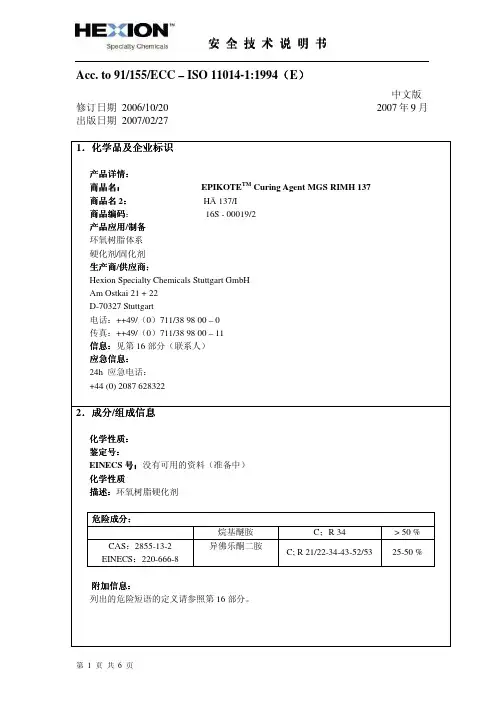
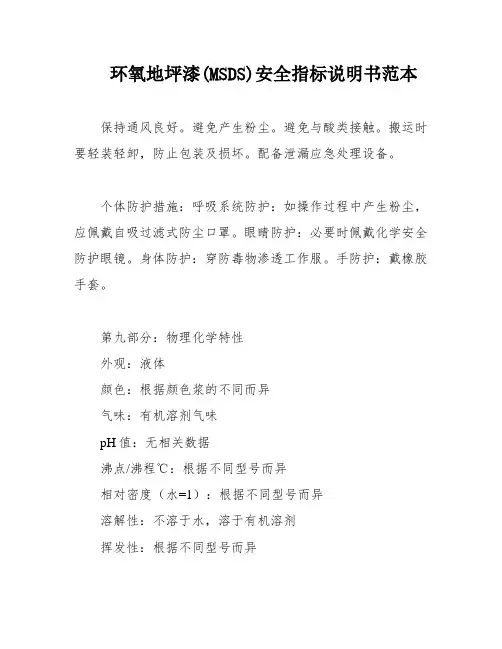
环氧地坪漆(MSDS)安全指标说明书范本保持通风良好。
避免产生粉尘。
避免与酸类接触。
搬运时要轻装轻卸,防止包装及损坏。
配备泄漏应急处理设备。
个体防护措施:呼吸系统防护:如操作过程中产生粉尘,应佩戴自吸过滤式防尘口罩。
眼睛防护:必要时佩戴化学安全防护眼镜。
身体防护:穿防毒物渗透工作服。
手防护:戴橡胶手套。
第九部分:物理化学特性外观:液体颜色:根据颜色浆的不同而异气味:有机溶剂气味pH值:无相关数据沸点/沸程℃:根据不同型号而异相对密度(水=1):根据不同型号而异溶解性:不溶于水,溶于有机溶剂挥发性:根据不同型号而异第十部分:稳定性和反应性稳定性:稳定危险反应:避免与酸类接触聚合危险性:不会发生聚合反应第十一部分:毒理学信息急性毒性:口服:LD50>5000mg/kg(大鼠);皮肤:LD50>2000mg/kg(大鼠);吸入:LC50>5.1mg/L(大鼠)慢性毒性:无相关数据致癌性:无相关数据致畸性:无相关数据致敏性:有致敏性,可能引起过敏性皮肤病第十二部分:生态学信息生态毒性:无相关数据生物降解性:无相关数据环境影响:避免其流入下水道/地表水/地下水第十三部分:废弃处置废弃处置方法:废弃物需按照当地法规进行处置。
废弃物应分类存储,不得与酸类等混合存放。
废弃物可送至专业处理厂进行处理。
第十四部分:运输信息包装标志:易燃液体包装方法:运输时应防止倾斜、撞击和日晒雨淋运输注意事项:按照国家相关法规进行运输第十五部分:法规信息符合国家相关法规第十六部分:其他信息本说明书中提供的信息是制定安全措施的参考,但不保证其准确性和完整性。
用户在使用本品时应自行判断其适用性。
生产厂商对本品的使用不承担任何责任。
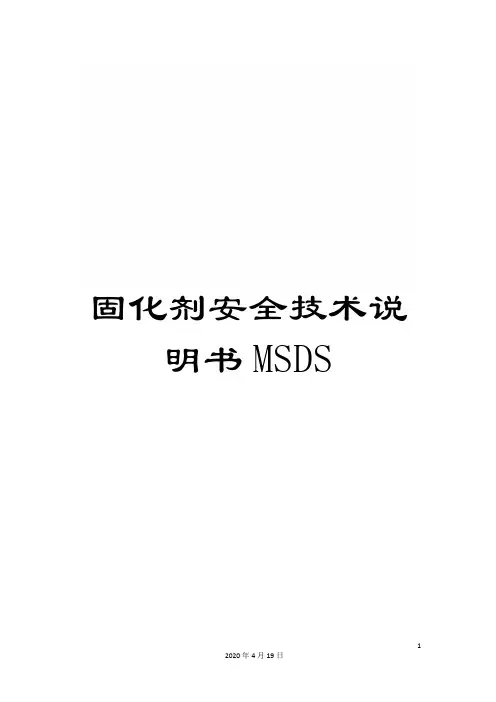
固化剂安全技术说明书MSDS安全技术说明书第一部分化学品及企业标识GHS产品标识符:固化剂产品类型:液体推荐用途和限制用途:仅用于专业的车辆油漆。
供应商的详细情况:增城市瀛泽化学工业有限公司地址:增城市石滩镇长江岭边邮编:511330电话:传真:国家应急电话:营运时间:24H第二部分危险性概述物质或混合物的分类:易燃液体 - 3急性毒性: 皮肤 - 5急性毒性: 吸入- 4皮肤腐蚀/刺激 - 2严重眼睛损伤/眼睛刺激性 - 2A呼吸或皮肤过敏——皮肤 - 1危害水生环境—急性危险 - 2特异性靶器官系统毒性一次接触 [麻醉效应]- 3化学品分类和标记全球协调体系(GHS)标签要素危险象形标记:警示词:警告危险性说明:易燃液体和蒸气。
吸入有害。
造成皮肤刺激。
造成严重眼刺激。
可能引起昏昏欲睡或眩晕。
对水生生物有毒。
防范说明预防措施:戴防护眼镜、防护面罩。
远离热源,火花,明火,热表面。
-- 禁止吸烟。
使用防爆电气、禁止排入环境。
事故响应:如吸入:将患者转移到空气新鲜处,休息,保持利于呼吸的体位。
如皮肤(或头发)接触:立即脱掉所有被污染的衣服。
用水冲洗皮肤或淋浴。
贮存:保持阴凉。
废弃处理:不适用不导致分类的其它危险:无资料第三部分成分/组成信息物质/制剂:混合物没有出现就供应商当前所知可应用的浓度,被分类为对健康或环境有害及因此需要在本节报告的添加剂。
职业暴露限制, 如果有的话, 列在第 8 节中。
第四部分急救措施注明必要的措施眼睛接触:立即用大量水冲洗眼睛,并不时提起上下眼睑。
检查和取出任何隐形眼镜。
冲洗至少十分钟。
寻求医疗救护。
吸入:将患者转移到空气新鲜处,休息,保持利于呼吸的体位。
如果仍怀疑有烟存在,救助者应当戴适当的面罩或独立的呼吸装置。
如沒有呼吸,呼吸不规则或呼吸停止,由受过训练的人员进行人工呼吸或给氧。
如使用嘴对嘴呼吸方法进行救助,可能会对救助者造成危险。
如有害的健康影响持续存在或加重,应寻求医疗救治。
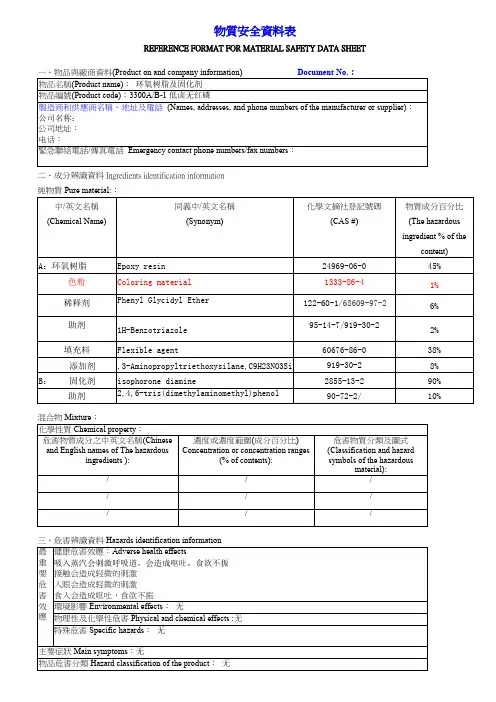
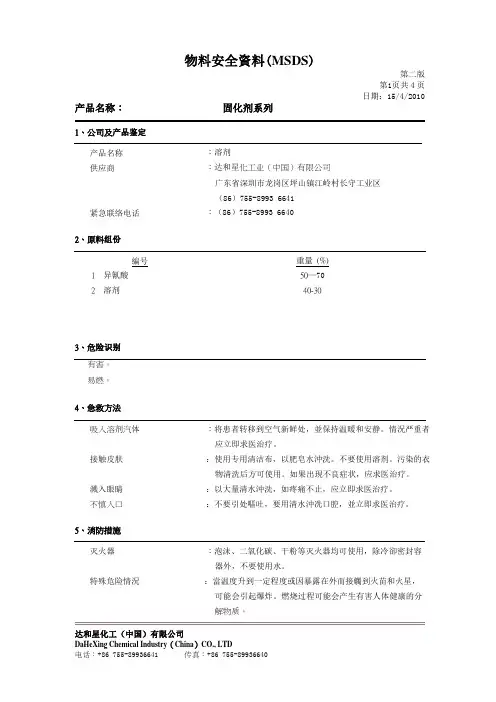
第二版 第1页共4页 日期:15/4/2010产品名称: 固化剂系列达和星化工(中国)有限公司1、公司及产品鉴定产品名称:溶剂供应商:达和星化工业(中国)有限公司广东省深圳市龙岗区坪山镇江岭村长守工业区 (86)755-8993 6641紧急联络电话 :(86)755-8993 66402、原料组份编号1 异氰酸2 溶剂重量 (%) 50—70 40-303、危险识别 有害。
易燃。
4、急救方法吸入溶剂汽体 接触皮肤 溅入眼睛 不慎入口:将患者转移到空气新鲜处,並保持温暖和安静。
情況严重者应立即求医治疗。
:使用专用清洁布,以肥皂水沖洗。
不要使用溶剂。
污染的衣物清洗后方可使用。
如果出現不良症状,应求医治疗。
:以大量清水沖洗,如疼痛不止,应立即求医治疗。
:不要引处嘔吐,要用清水沖冼口腔,並立即求医治疗。
5、消防措施灭火器特殊危险情況:泡沫、二氧化碳、干粉等灭火器均可使用,除冷卻密封容器外,不要使用水。
:當温度升到一定程度或因暴露在外而接觸到火苗和火星,可能会引起爆炸。
燃烧过程可能会产生有害人体健康的分解物质。
第二版 第2页共4页 日期:15/4/2010产品名称: 固化剂系列达和星化工(中国)有限公司消防保护設备 :建议使用自带氧气呼吸装置。
6、意外泄漏防护措施人员預防 环境預防 清除方法:去除火源。
在转移泄出來的液体時,确保空气流通和适当的人身保护。
避免皮肤及眼睛接触。
:未经处理的物料不能排放,以免污染环境,如流入下水道或阴沟,需通知政府有关部門协助处理。
:用沙子,泥土或其他有吸收能力的物质,將泄漏物吸收,然后裝入适当的容器中,按照当地的規章制度进行处理。
操作时需使用不产生火花的工具。
7、搬運和儲存搬运 储存:在搬运时,不要破坏容器。
确保储存所用之容器和运送設备接地。
杜绝火焰和任何火源。
确保处理现场通风良好。
:罐蓋要盖紧,存放在涼爽干燥处。
同時本产品应放在小孩接触不到的地方。
8、暴露控制/人身防護职业暴露限度(OEL) 呼吸保护 手防护 皮肤防护 眼睛防护:8小時內允許空气浓度 – 100ppm , 10分钟內最高 – 150ppm 。
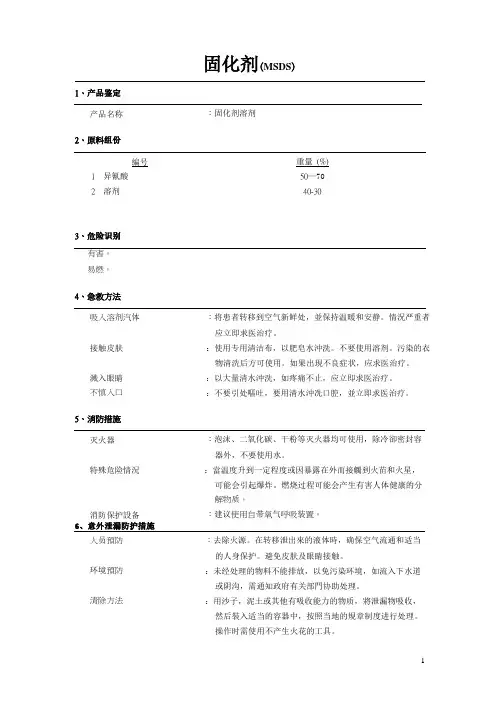
1、产品鉴定产品名称:固化剂溶剂2、原料组份编号1 异氰酸2 溶剂重量(%) 50—70 40-303、危险识别有害。
易燃。
4、急救方法吸入溶剂汽体接触皮肤溅入眼睛不慎入口:将患者转移到空气新鲜处,並保持温暖和安静。
情況严重者应立即求医治疗。
:使用专用清洁布,以肥皂水沖洗。
不要使用溶剂。
污染的衣物清洗后方可使用。
如果出現不良症状,应求医治疗。
:以大量清水沖洗,如疼痛不止,应立即求医治疗。
:不要引处嘔吐,要用清水沖冼口腔,並立即求医治疗。
5、消防措施灭火器特殊危险情況消防保护設备:泡沫、二氧化碳、干粉等灭火器均可使用,除冷卻密封容器外,不要使用水。
:當温度升到一定程度或因暴露在外而接觸到火苗和火星,可能会引起爆炸。
燃烧过程可能会产生有害人体健康的分解物质。
:建议使用自带氧气呼吸装置。
6、意外泄漏防护措施人员預防环境預防清除方法:去除火源。
在转移泄出來的液体時,确保空气流通和适当的人身保护。
避免皮肤及眼睛接触。
:未经处理的物料不能排放,以免污染环境,如流入下水道或阴沟,需通知政府有关部門协助处理。
:用沙子,泥土或其他有吸收能力的物质,將泄漏物吸收,然后裝入适当的容器中,按照当地的規章制度进行处理。
操作时需使用不产生火花的工具。
7、搬運和儲存搬运储存:在搬运时,不要破坏容器。
确保储存所用之容器和运送設备接地。
杜绝火焰和任何火源。
确保处理现场通风良好。
:罐蓋要盖紧,存放在涼爽干燥处。
同時本产品应放在小孩接触不到的地方。
8、暴露控制/人身防護职业暴露限度(OEL) 呼吸保护手防护皮肤防护眼睛防护:8小時內允許空气浓度– 100ppm,10分钟內最高– 150ppm。
:正常的工作环境应有适当的空气流通和能及時排出的溶劑蒸汽,如果蒸汽浓度超过规定限度,使用呼吸裝置提供适当的新鮮空气。
:配戴聚氯乙烯、丁睛橡膠、聚氨脂或其它适宜材料制成的手套。
:穿着适当的防护服裝,脫去已污染的衣服,以避免接触到皮肤。
:配戴护目镜或有側面保护的安全镜。
化学品安全技术说明书第1部分化学品及企业标识化学品中文名:环氧漆固化剂化学品英文名:Epoxy resin coating curing agent生产企业名称:广东德丽雅漆业有限公司地址:广东省韶关市翁源县翁城镇华彩化工涂料城B-15-2地块电话:传真:企业应急电话:国家应急电话:0电子邮件地址邮编:512627推荐用途:主要用于建构筑表面、金属表面的涂饰。
限制用途:限制用于化妆品、食品、饮料等。
SDS编号:DLY10编制日期:2016年9月1日编制说明:第一版第2部分危险性概述危险性类别:易燃液体 2类象形图:危险性说明:高度易燃液体和蒸气警示词:危险防范说明:【预防措施】远离明火、热源、火花、热表面。
使用不产生火花的工具作业。
生产过程中尽可能保持容器密闭。
生产设备、设施及管道等应采取防静电措施,容器和接收可靠接地、跨接。
生产场所使用防爆电器、通风、照明及其他设备。
作业人员需戴防护手套、防护眼镜、防护面罩。
操作后彻底清洗身体接触部位。
作业场所不得进食、饮水,严禁吸烟。
物料禁止直接排入环境。
【事故响应】皮肤(或头发)接触,立即脱掉所有被污染的衣帽。
用水冲洗皮肤、淋浴。
食入:催吐,立即就医。
及时收集泄漏物。
火灾时,使用干粉、抗溶性泡沫、二氧化碳灭火。
【安全储存】在阴凉、通风良好处储存。
【废弃处置】本品或其容器采用焚烧法处置。
侵入途径:吸入、食入、经皮吸收健康危害:生产和使用的工人,可有头痛、恶心、食欲不振、眼灼痛、眼睑水肿、上呼吸道刺激、皮肤病症等。
本品的主要危害为引起过敏性皮肤病,其表现形式为瘙痒性红斑、丘疹、疱疹、湿疹性皮炎等。
环境危害:该物质对环境可能有危害,对水体应给予特别注意。
燃爆危险:本品易燃,具刺激性,具致敏性。
第3部分成分/组成信息纯品混合物组分信息:第4部分急救措施皮肤接触:先用少量稀料擦清油污,再用肥皂彻底洗涤。
眼睛接触:提起眼睑,用流动清水或生理盐水冲洗。
就医。
吸入:应使患者脱离污染区,安置在通风地点休息并保暖。
化学品安全技术说明书第1部分化学品及企业标识化学品中文名:环氧漆固化剂化学品英文名:Epoxy resin coating curing agent生产企业名称:广东德丽雅漆业有限公司地址:广东省韶关市翁源县翁城镇华彩化工涂料城B-15-2地块电话:传真:企业应急电话:国家应急电话:0电子邮件地址邮编:512627推荐用途:主要用于建构筑表面、金属表面的涂饰。
限制用途:限制用于化妆品、食品、饮料等。
SDS编号:DLY10编制日期:2016年9月1日编制说明:第一版第2部分危险性概述危险性类别:易燃液体 2类象形图:危险性说明:高度易燃液体和蒸气警示词:危险防范说明:【预防措施】远离明火、热源、火花、热表面。
使用不产生火花的工具作业。
生产过程中尽可能保持容器密闭。
生产设备、设施及管道等应采取防静电措施,容器和接收可靠接地、跨接。
生产场所使用防爆电器、通风、照明及其他设备。
作业人员需戴防护手套、防护眼镜、防护面罩。
操作后彻底清洗身体接触部位。
作业场所不得进食、饮水,严禁吸烟。
物料禁止直接排入环境。
【事故响应】皮肤(或头发)接触,立即脱掉所有被污染的衣帽。
用水冲洗皮肤、淋浴。
食入:催吐,立即就医。
及时收集泄漏物。
火灾时,使用干粉、抗溶性泡沫、二氧化碳灭火。
【安全储存】在阴凉、通风良好处储存。
【废弃处置】本品或其容器采用焚烧法处置。
侵入途径:吸入、食入、经皮吸收健康危害:生产和使用的工人,可有头痛、恶心、食欲不振、眼灼痛、眼睑水肿、上呼吸道刺激、皮肤病症等。
本品的主要危害为引起过敏性皮肤病,其表现形式为瘙痒性红斑、丘疹、疱疹、湿疹性皮炎等。
环境危害:该物质对环境可能有危害,对水体应给予特别注意。
燃爆危险:本品易燃,具刺激性,具致敏性。
第3部分成分/组成信息纯品混合物组分信息:第4部分急救措施皮肤接触:先用少量稀料擦清油污,再用肥皂彻底洗涤。
眼睛接触:提起眼睑,用流动清水或生理盐水冲洗。
就医。
吸入:应使患者脱离污染区,安置在通风地点休息并保暖。